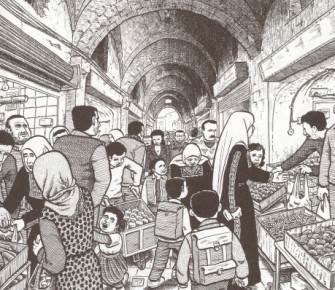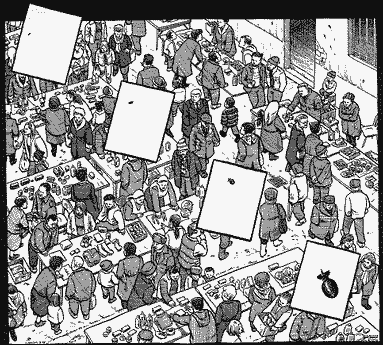Serendip is an independent site partnering with faculty at multiple colleges and universities around the world. Happy exploring!
Towards Day 20: "WIERD"??

course notes by platano 
From Joe Sacco's Palestine
I. coursekeeping
today's notetakers: SandraM and Kat
for Tuesday, read the first 50 pp. (through Chapter 6) of Rebecca Skloot's The Immortal Life of Henrietta Lacks, and 50 pp. more (for next Thursday, read the last 50 pp....and 50 pp. more);
there are 3 sections: Life, Death, and Immortality
Reminder this afternoon and Friday: RE: Humanities @ HC: A Symposium on Digital Media in Academia
Cf. w/ ckosarek's observation, while I was out of town, that "If a class is invested in the material, then perhaps the line between teacher and student disappears," an essay called "Learning from Nobody: The Limited Role of Teaching in Folk Models of Children's Development," by David Lancy, who's coming to speak @ HC on Friday afternoon:
* First what's cute about it is that it calls the contemporary world's intelligentsia (='Western, Educated, Industrialised, Rich and Democratic") a "WIERD" society. Next what's interesting is that it calls WIERD's assumption that children learn by active teaching just plain, well, WIERD. Mostly--based on lots of ethnography work through history and across time--children have been assumed to be self-guided in their learning, and teaching was seen as diverting the children's character and sense of autonomy: “Much of the WEIRD model has been constructed in the very recent past…a dramatic rise in time spent in child care by college-educated parents appears to coincide with increased competition for places in elite colleges."
Punch line: "the great antiquity… of extra-scholastic teaching…are predicated on models of brain evolution and human development focused on tool-making and information processing....Indeed, teaching does have some efficiencies when it comes to transmitting large quantities of information or complex processes. On the other hand, if your theory emphasises brain growth to cope with an increasingly complex social world, then teaching does not seem so helpful. Learners should deploy their attention widely…rather than focusing on just a single teacher….
"The kind of nuanced, student-centered, developmentally appropriate instruction by dedicated adults that we today take as the operational definition of teaching is a recent product of a long process of educational change….Teaching has been largely superfluous in the process of cultural transmission throughout human history….On the other hand, the current 'information' economy may be driving the ever-more demanding school curriculum. School entrance/graduation exams…provide a Darwinian environment in which parents who teach…are rewarded..."
II. background re: the constructedness of culture, for our further discussion of Path to Paradise
kgould: Appiah asks us to live together....**
EVD: Washington Times Review of Path to Paradise: "The Path to Paradise is essential reading for understanding Palestinian suicide terrorism and the measures required to resolve it" .... I really felt like it didn't at all suggest a method for improving relations in the Middle East .... the book suggested that recruitment of suicide bombers involves so much more than religious and political pressure ... the measures required to resolve this conflict do not necessarily involve the individual but rather the system which takes advantage of the individual...I didn't find that she was trying to convey methods to resolve the conflict as a whole.
ckosarek, Collectivism As a Cause for Suicide: In the final pages of The Path to Paradise, suicide bombing is called "a very private act" . . . I think this plays into the western perception of suicide ... a solitary thing ... isolated from culture .... Calling the suicide bombers' suicides a "private act" seems inaccurate .... I came across ... an article by Ofed Grosbar called "The Drama of the Suicide Terrorist" .... paints the suicide bombers' deaths as a collectivist action brought on by a culture of trauma. To understand their suicides, one must understand what it means to take group feelings as (or more) personally than one's own. Perhaps this is where the author had trouble in constructing her book .... she seemed to fracture the sterngth of collectivism by breaking the suicide bombing operations into components (i.e. bombers, dispatchers). As a follow-up to this book, I ask what it feels like to be so invested in a culture, that its emotions become confused with one's own. How does it feel when a choice to die is not personal, but is rather personalized by means of being sociopolitical?
Smacholdt, It's all perspective: I think that something that Berko does well is shed another light on the Israeli/ Palestinian conflict... portray the story from an angle that is unusual for many westerners ... how much a story changes depending on your prospective ... she has a large stake in the conflict
rachelr: I hope that in our discussion we can move ... onto the form and how we can look at this as non-fiction. Is it non-fiction through and through? And are there perhaps sub-stories that could be fictitious?
Where we stopped ("evaluating an ethnography"): Expresses a Reality: "Does it seem 'true'—a credible account of a cultural, social, individual, or communal sense of the 'real'?"
- a firm distinction between the 'dispatchers,' the strong ones, the ideologues, and the suicide-bombers, weak personalities with family problems?
- human beings as "smart bombs"?
reading notes, continued.....
p. 31: more murders, higher status
p. 42: "they reconcile the apparent contradiction [of being morally normative] by viewing themselves as the affronted, as those treated unjustly, and they see their acts of murder as legitimate...convincing themselves that they are the real victims."
p. 46: "Inshallah": "with the help of Allah"; "may it come to pass"
p. 48: manifesting masculinity
p. 52: "the meaning of jihad: let there be peace"
p. 74f: Arab women and Internet chat rooms
p. 87: "they wanted the Israelis to feel what we feel. That isn't revenge..."
p. 112: "It's more impressive when a woman carries out a suicide bombing attack, because this is the Middle East and a woman is very limited, and that makes her action special."
p. 114: female suicide bombers...were the expression of a unique wave of feminism, which allowed them to improve their social status
p. 126: "They never pitied our children and I'm simply returning the favor, feel what we feel!"
p. 128: there is no basis in fact for the claim...
p. 132: "when I changed my mind, those who sent me out told me that I didn't have the right...."
p. 148: all the territory of "Palestine," that is, Israel
p. 154: "That day was like a present...The world was open for me...."
p. 155: The kamikazes were Japanese suicide pilots who limited their attacks to American warships...the phenomenon did not "spread" anywhere. As a tool to demoralize Israel, gain political ends and incidentally kill as many Jews as possible, suicide bombing was used by the Palestinian terrorist organizations....
p. 156: "The shuhada [dying for the sake of Allah] is a status, not murder, and it is Allah who grants the status. The shuhada is not the automatic product of killing others, but a virtue given by Allah as a reward."
p. 157: "When you see America from the outside it's like a nice big watermelon, but when you cut into it you see it's full of worms. With us, in Muslim society, the watermelon is already open, so you can see the good part and the rotten part."
p. 163: what women got in Paradise
p. 171: The shaheeds and shaheedas are not the heroes they are made out to be...they are the antitheses of the classic hero and heroine, marginal individuals.
p. 172: The shaheed's act can be viewed as a kind of expressive suicide.
p. 173: during the modern age...suicide for religious reasons is the province of Islam...It is instrumental suicide terrorism, in which the act of blowing oneself up serves a tool for achieving a political or ideological goal.
The suicide bombers are murderers, but even before that they are victims and scapegoats of Palestinian society...dispatchers...were merely whistling teakettles..not yet turned into steam engines...
The dispatchers judge issues according to two polarized criteria: one is normative and humane, and is used with regard to their own people, and the other is to delegitimize and dehumanize the victims of their terrorism.
p. 174: there is a profound, insoluble conflict between the Western world and the Arab/Muslim world...
Those who deal with the murderous industry of suicide bombing attacks have no moral sense....
![]()
** senior thesis re: how the comic allows a fuller interaction w/ place/space
Jorn Ahren and Arno Meteling, Comics and the City: Urban Space in Print, Picture and Sequence
Simon Schama, Landscape and Memory (on the ways in which memory inprints itself on the world)
YiFu Tuan, Space and Place: The Perspective of Experience
Pascal Lefevre, The Construction of Space in Comics
Valerie Preston and Ebru Ustundag, Feminist Geographics of the "City"

course notes by platano


